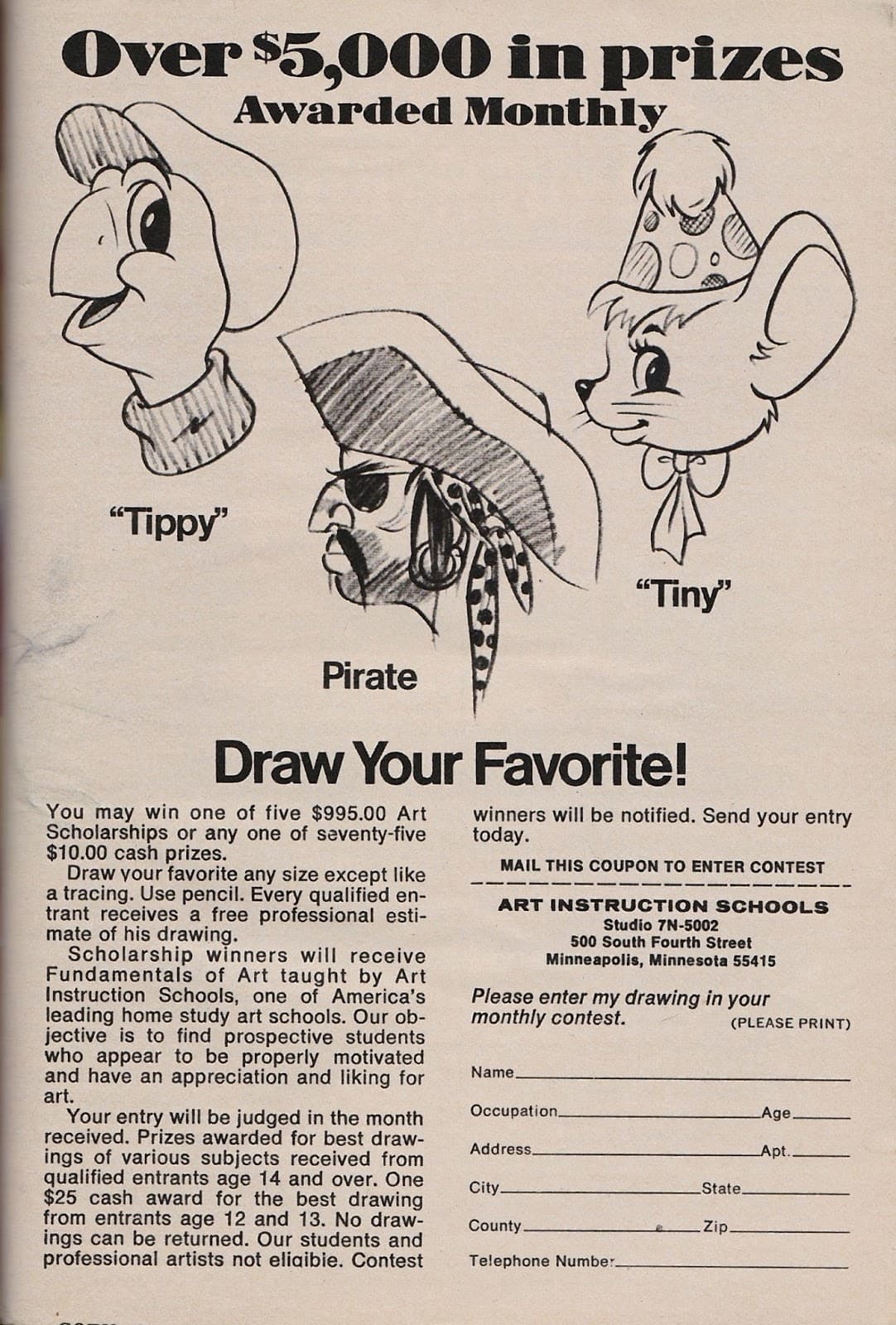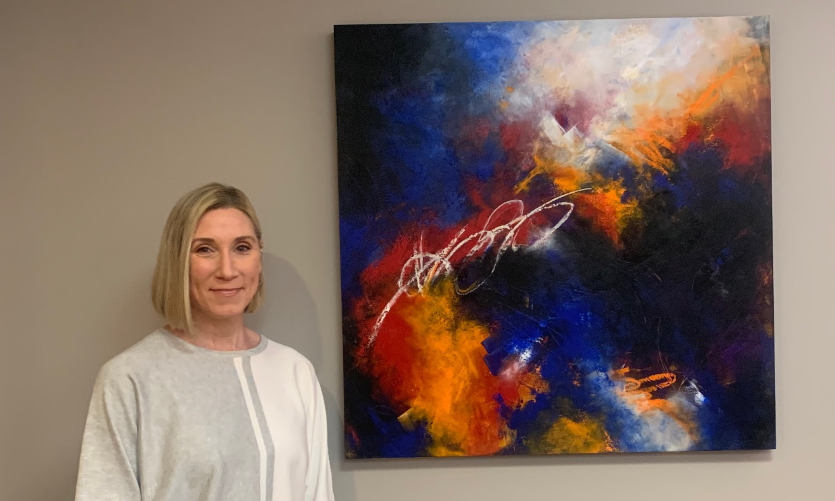Balthazar Fetsko Shares Fine Art at Scranton

By: Claire Sunday, '23, student correspondent
Even for artists who never show their work, "being creative is meditative and healing in many ways," explains Kym Balthazar Fetsko, an award-winning illustrator for two decades.
The artist and University staff member for the Weinberg Memorial Library discusses her transition from illustration to painting, advice for budding artists and the inspiration behind her art.
While her artwork is featured in many private collections throughout the United States, the Dunmore, Pennsylvania, resident has recently found a local home for some of her paintings at the University, where she has been on staff since 2005. The paintings, which feature an abstract style, are currently on display at the Weinberg Memorial Library's fourth floor Quiet Study Room.
Balthazar Fetsko is a graduate from the University of the Arts, where she received her Bachelor of Fine Arts in illustration in 1995. Her work has been displayed at Art of the State-Pennsylvania, the Rice Gallery of Fine Art Juried Exhibition, and The SDMAAG Spring 2022 Exhibition.
What prompted your interest in art?
 "Art has been a part of my life for as long as I can remember. Like most kids in the '70s and '80s, we had to entertain ourselves. I was constantly sketching or coloring. Some of my earliest endeavors were drawing Looney Tunes characters. As I got older, I would challenge myself to draw Tippy the Turtle, or the pirate, (a certain generation will know what I’m talking about!) determined I had what it took to be a serious art student. And I did become an art student, graduating from the University of the Arts with a BFA in Illustration."
"Art has been a part of my life for as long as I can remember. Like most kids in the '70s and '80s, we had to entertain ourselves. I was constantly sketching or coloring. Some of my earliest endeavors were drawing Looney Tunes characters. As I got older, I would challenge myself to draw Tippy the Turtle, or the pirate, (a certain generation will know what I’m talking about!) determined I had what it took to be a serious art student. And I did become an art student, graduating from the University of the Arts with a BFA in Illustration."
How would you describe your style of art?
"I was a freelance illustrator for over 20 years, where my focus was caricatures for editorial publications like The Columbia Journalism Review, FAIR, XXL, and numerous alt weeklies from one end of the country to the other. The industry is changing, however, with a lot of publications closing altogether or going fully digital without buying art anymore. And, truth be told, I just wasn’t enjoying it anymore and was itching for a change.
Along came Covid and the lockdowns, so I took advantage of that time at home to transition to abstract painting, which I’ve always enjoyed but never had the time to pursue. I first dabbled in encaustic painting where you need to heat each wax layer in order to fuse them together. Having a home studio had me reconsider that medium, so I switched over to cold wax, which is beeswax with a little solvent and resin. As the solvent evaporates out of the medium, the soft wax hardens to the density of a beeswax candle. Mixing the cold wax in with oil paint makes the paint thicker and more matte. It also slightly speeds drying time."
What inspires you in your work?
"My work is intuitive and usually inspired by my mood, music, or my surroundings (i.e., a walk in the woods or an afternoon at the beach.)"
Did you have any mentors? If so, who?
"My work has been influenced by the New York School artists, particularly Joan Mitchell, and Jasper Johns.
On the illustrative side, no one could paint an atmosphere quite like Maxfield Parrish. And Norman Rockwell and J.C. Leyendecker dominated editorial illustration during the early 1900s with a style I have always revered."
What advice do you have for budding artists?
"It’s cliché, but don’t give up. I’m only now focusing on, and realizing my potential as an artist. While the creative side was always there, daily life duties have a way of pushing passions to the back burner for a time. But for artists the urge is always there, and it needs to be fed. Even if you decide to never show your work, being creative is meditative and healing in many ways. For me, it has balanced so many facets of my life."
What are some challenges that artists face in their careers today?
"The road to becoming a lucrative artist is not an easy one to travel, but social media is changing the game. Artists have the opportunity for a far broader reach which in turn equals, hopefully, more buyers and exhibition opportunities. Time will always be a challenge. There are not enough hours in the day to accomplish all that needs to be done and sometimes spending time in the studio is the last thing you feel like doing. But creative practice is important, so I encourage even 15 minutes of sketching or art journaling."
What opportunities have you found in Scranton with your art?
"I have an ongoing relationship with Art e’Fekts Gallery in Pittston, where my work is on display and I teach classes. Speaking of classes, I’ve had the wonderful experience of teaching my Oil and Cold Wax Abstracts for Beginners course in Carbondale, Scranton, and Clarks Summit this past year. I am now developing it into a self-paced online course that will be available in April.
While Scranton doesn’t have many galleries, we do have a robust First Friday with local establishments opening their doors to show local artists. I’ve had the opportunity to show at AFA Gallery, a pop-up exhibition at 200 Adams, and various other Scranton locations. I am looking forward to an artist’s reception in June at Art e’Fekts Gallery in Pittston and a large solo exhibition at ArtWorks Gallery on Penn Avenue in October 2023."
Knowing what you know now, what advice would you have given yourself at the start of your career?
"Choose an art discipline based on what appeals to you most. I went into illustration thinking only the elite with gallery connections could ever become painters. It seemed the safer route. My advice is – don’t play it safe. It’s art. It comes from within and the world deserves to see that unique voice in whatever form you wish it to take."






